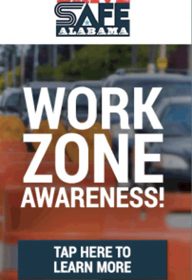Fifty-four percent of highway contractors report that motor vehicles crashed into their construction work zones during the past year, according to a recent highway work zone study. In response, Associated General Contractors of America pursued a mobile advertising campaign urging drivers who routinely pass through certain work zones to slow down and be alert.
|
|
 |
 |
| The AGC work zone safety study was based on an April-May survey, drawing responses and perspective from 550-plus highway contractors nationwide. Results prompted the mobile advertising campaign, piloted in Alabama, Missouri and Pennsylvania. |
“There are simply too many cars crashing into too many work zones, putting too many lives at risk,” says Granite Construction Western Region Projects Executive Ken Kubacki, who chairs the AGC Highway and Transportation Division. “We are using targeted technology to urge motorists to slow down and drive with care in highway work zones.”
Of more 500 contractors responding to an AGC survey, 48 percent who reported work zone crashes on their projects said that motor vehicle operators or passengers were injured, and 24 percent of those crashes involved a driver or passenger fatality. Highway work zone crashes also pose a significant risk for construction workers, Kubacki notes, as 25 percent of such incidents injure crews, while 3 percent result in worker fatalities. Work zone crashes also have a pronounced impact on construction schedules and costs, he adds, noting how 53 percent of contractors surveyed indicate that highway projects have been delayed at least a day during the past 12 months because of work zone crashes. The survey further finds that 74 percent of respondents report they feel highway work zone crashes pose a greater risk now compared to a decade ago.
Association officials launched a targeted mobile advertising campaign designed to reach regular highway work zone drivers and urge them to be careful in roadside construction sites before the start of the traditional summer driving season. Mobile device-equipped drivers navigating highway work zones in Pittsburgh and St. Louis, plus Birmingham, Ala., and Evansville, Ind., receive special work zone safety messages. The ads were programmed to appear only when the drivers open their mobile phones and either visit a web browser like Chrome or Safari, or use an app with advertisements. The campaign is crafted that way to avoid distracting drivers while they are on the road, instead reaching them when they can safely use their phones. During its first weeks, the campaign saw delivery of safety messages to 1.5 million mobile devices; several thousand recipients clicked through to highway work zone safety tips.
“We are using technology to make sure one hundred percent of our ads are reaching work zone motorists,” Kubacki affirms. “Instead of trying to sell something, we are harnessing mobile advertising technology to save as many lives as possible.”
ACCIDENT PREVENTION: FIVE BEST PRACTICES


